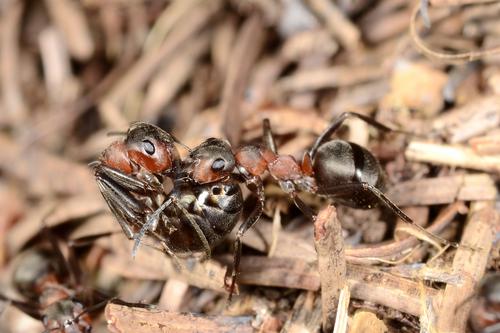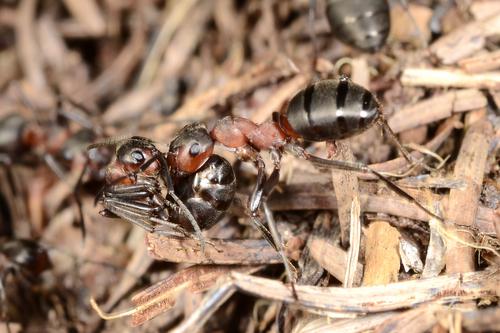Observations of Formica rufa (Linnaeus, 1761) Hymenoptera, carrying another ant at Ribbesford Wood, Worcestershire
John Bingham
Whilst in Ribbesford Wood on the 2nd March 2013 I was looking at a colony of Formica rufa (wood ants) with hundreds of individuals massing on top of the nest. This behavior is quite common and typically seen in early spring with ants grouped on the outside of the nest. It is thought that they are absorbing heat from sunshine and assumedly transferring the heat energy into the nest. (Skinner 1998). Whilst I was watching the activity I noticed several ants carry back to the nest a prey item in their mandibles. It appeared to be another ant of some type and looked to be dead. I collected several of these ants and found that the 'prey' item was in fact another Formica rufa ant, perfectly healthy and active once released from the other ant’s mandibles.
Whilst ants constantly carry all manner of items back to the nest such as prey, twigs, leaf fragments, pine needles and seeds etc, I cannot recall seeing them carry live ants before. Possibly I have not been that observant but I am fairly certain that during the summer, despite looking at ant activities, I have never witnessed such behavior. I can find nothing about this except that ants do move and carry other ants if moving nest sites (Pontin 2005). However, in this case all the ants were returning towards the nest as if they were returning with exhausted fellow ants. The air temperature was cool, 3-4°C, so I wondered if they were getting chilled, but they were still very active once collected?
I spent an interesting 30 minutes trying to photograph the activity during which time ants carrying ants appeared every 10 seconds or so in a steady stream back to the nest. The ants were locked mandible to mandible with the gaster of the carried ant tucked tightly under the head of the other. (See photographs).
I sent an image to various people and Geoff Trevis kindly forwarded it to Mike Fox at BWARS who commented that; 'ants do often carry one another.... photo shows the typical carrying method well. At this early date in the season it is possible that some of the workers had got chilled and become torpid and livelier ants were carrying them back to the nest where they could warm up'.... 'Some workers spend the majority of their time doing absolutely nothing. It could be that some of these "lazy" ants were found stationary outside the nest and this prompted their nest mates to pick them up'.
This seems a plausible answer, so ants get exhausted in cold weather and need a lift back to the nest to warm-up! Unless anyone can come up with another explanation?
References
Skinner, G. J. 1998. British Wood-ants. British Wildlife 10(1):1-8
Pontin, J. 2005. Ants of Surrey Surrey Wildlife Trust.
Image
Fig. 1. Formica rufa carrying another ant. John Bingham
Fig. 2. Formica rufa carrying another ant. John Bingham

